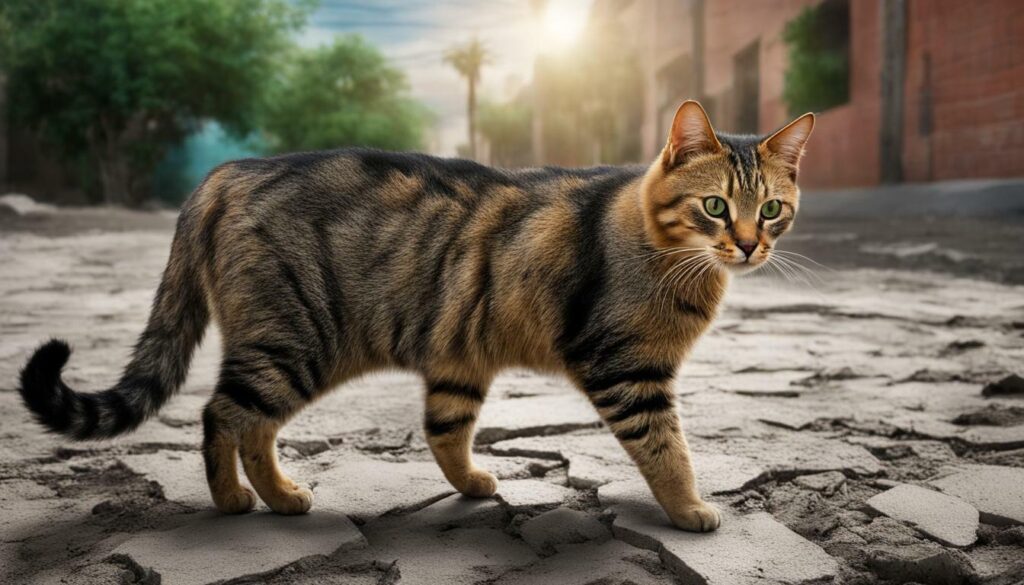Table of Contents
Climate change affects not only humans and wildlife but also the lives of stray cats. Stray cats are particularly vulnerable to the impact of climate change, which can cause long-term effects on their well-being, habitats, and food sources. With the rise of global temperatures, extreme weather events, and natural disasters, the survival of feral cats is endangered.
Climate change can lead to a scarcity of resources such as food and water, which can force stray cats to search for resources in urban areas, increasing the risk of disease and conflict with humans. Changes in temperature and precipitation patterns can also alter the behavior and reproductive cycles of feline populations.
In this article, we will explore the relationship between climate change and stray cats, the environmental impact on feral cat population and habitats, and ways to adapt stray cat care in the face of climate change.
Key Takeaways:
- Climate change can have a detrimental impact on the survival of stray cats
- The scarcity of resources and changes in temperature and precipitation patterns can alter the behavior and reproductive cycles of feline populations
- Adapting stray cat care is necessary to combat the effects of climate change on feral cats
The Relationship Between Climate Change and Stray Cat Population
Climate change has a significant impact on the survival of stray cats and their population. The stray cat population is affected by multiple environmental factors, including extreme weather conditions, rising temperatures, and habitat loss. As a result, feral cats are experiencing severe droughts, floods, and heatwaves that force them to seek shelter and food in different areas, disturbing the balance of their ecosystem.
Stray cats are vulnerable to the consequences of climate change, as their natural habitats are destroyed by floods and landslides, and their food sources, such as rodents, are decreasing with the lack of vegetation. The warming climate has also increased the likelihood of natural disasters and disease outbreaks, which severely impact the survival of stray cats.
Moreover, the environmental impact on feral cat survival also affects their reproduction rate. As the climate changes, female cats tend to reproduce less frequently, due to the changes in their bodily functions and the harsher environmental conditions. This results in fewer kittens born, reducing the cat population over time.
In conclusion, the relationship between climate change and the stray cat population is undeniable. The environmental impact on feral cat survival affects their reproduction rate and their ability to thrive in their natural habitats. As the climate continues to warm, it is essential to address these issues and adapt to new methods of stray cat care to ensure their well-being and survival.
Climate Change’s Effect on Stray Cat Habitats
Climate change not only affects the temperature but also the natural habitats of animals, including stray cats. The consequences of climate change for stray cats are quite severe, as it results in changes to their living conditions and access to basic resources. The increasing frequency and intensity of natural disasters such as floods, hurricanes, and wildfires make it difficult for stray cats to survive in the wild.
The increase in temperature and the decrease in rainfall cause water scarcity, which affects the availability of food and water sources for stray cats. Stray cats primarily depend on natural resources such as water bodies, trees, and shrubs, which provide food and shelter. The changing climate affects the availability of these resources, making it difficult for stray cats to find a safe and stable environment.
| Consequences of Climate Change for Stray Cats |
|---|
| 1. Limited access to food and water |
| 2. Difficulty in finding shelter |
| 3. Increase in the frequency and intensity of natural disasters |
As a result of these changes, many stray cats are forced to migrate and search for alternative habitats. These migrations can be dangerous and lead to injuries or fatalities. In some cases, the migration of stray cats can also result in an increase in the transmission of diseases, which can be dangerous to both humans and animals in the area.
The consequences of climate change for stray cats are not only physical but also psychological. Stray cats are known to have a strong attachment to their surroundings and may suffer from anxiety, depression or fear due to the changes in their habitats. This can affect their behavior and make it more difficult for them to interact with other animals and humans.
In conclusion, climate change has a devastating effect on the habitats of stray cats. It affects their access to basic resources such as food and water, and their safety. Stray cats are resilient and can adapt to changing environments, but the scale and speed of climate change makes it difficult for them to survive. It is essential to take measures to mitigate climate change and protect the habitats of stray cats and other animals.
The Impact of Global Warming on Stray Felines
Global warming, a primary consequence of climate change, affects stray cats in profound ways. Increasing temperatures and extreme weather events have led to severe environmental changes, which have impacted the feline population in multiple ways.
Rising temperatures have altered the ecology of regions, reducing food and water resources for stray cats. The extreme heat has also led to dehydration and exhaustion, forcing many cats to move to new areas in search of sustenance. With the migration of these cats, there is an increase in competition for limited resources, leading to inhumane activities, such as fighting and territorial disputes.
The changing climate has also made it more challenging for stray cats to find shelter and safety. Extreme weather events, such as storms and floods, destroy makeshift shelters and habitats of homeless felines, leaving them without any protection or refuge. The increased frequency of these incidents has made it challenging for animal welfare organizations and volunteers to keep up with their care and rescue efforts.
The impact of global warming on stray felines is not limited to environmental changes alone. The changing climate has also affected the health of homeless cats adversely. With the increase in global temperatures, the breeding patterns of disease-carrying insects, such as fleas and ticks, have been altered. This change has led to an increase in the prevalence of diseases among stray cats, leading to a decrease in their overall health and wellbeing.
Climate change effects on homeless cats go beyond the immediate issues of food, water, and shelter. It also affects the welfare of the larger feline community. In a rapidly changing eco-system, it can become challenging for animal welfare organizations to keep up with the changes and provide appropriate care and support.
The impact of climate change on stray cats is a growing concern, and it is essential to adapt the care and management of these felines to the changing needs of the environment.
The Stray Cat Community and Climate Change
Climate change not only affects the environment but also the lives of stray cats. The community of stray cats faces a higher risk of health problems, hunger and thirst, and exposure to extreme weather conditions such as heatwaves and floods. These challenges are likely to worsen as the planet’s temperature continues to rise.
Global warming is drastically changing the world, and the stray cat community is not immune to its impact. The rising temperatures lead to droughts and heatwaves, which reduce the availability of water and food for stray cats. Additionally, the extreme weather conditions make it difficult for these cats to find safe and sheltered places to rest, which puts them at risk of injury and illness.
The welfare of stray cats is a growing concern as climate change takes hold. These felines have become an important part of many communities, and their presence can have both positive and negative effects. Some people may feed and care for stray cats, while others may view them as a nuisance or a health threat. Regardless of how they are perceived, stray cats face a tough road ahead as the planet continues to heat up.
The Human Factor
While climate change affects the lives of all living beings, humans have the power to make a difference in the lives of stray cats. Individuals and communities can help by taking action to reduce their carbon footprint, such as using renewable energy sources, reducing waste, and supporting sustainable practices. Additionally, people can make a difference by supporting organizations that provide care and support to the stray cat community.
Efforts to reduce the impact of climate change on the stray cat community include providing food and water during extreme weather, creating shelters that offer protection from the sun and rain, and offering medical care to cats in need. By supporting these initiatives, people can make a real difference in the lives of stray cats and ensure that their welfare is taken care of.
Conclusion
The effects of climate change are far-reaching and will continue to impact all living beings on this planet, including stray cats. However, by taking action to reduce our carbon footprint and supporting efforts to care for the stray cat community, we can help mitigate some of the negative effects of climate change and ensure a better future for all.
Adapting Stray Cat Care in the Face of Climate Change
As the impact of climate change on stray cats becomes more apparent, it is essential to adapt their care to ensure their welfare. With rising temperatures, changing weather patterns, and extreme weather events, it is crucial to take proactive measures to protect stray felines.
One way to adapt stray cat care is by providing them with access to clean water regularly. Due to increased droughts and heatwaves, cats in urban areas may struggle to find water sources. Placing water stations in areas with high stray cat populations can help mitigate this problem.
Additionally, providing shaded areas or shelters can help feral cats during extreme weather conditions. As temperatures rise, it is vital to ensure that stray cats can seek refuge from the sun. Providing shelters or shaded areas in public spaces can help protect stray cats from the sun’s harmful rays.
Changes in weather patterns can also affect food sources for stray cats. Natural food sources may become scarce or unavailable, leading the cats to scavenge for food in urban areas, potentially causing conflict with humans. To address this, it is essential to provide regular feeding stations for stray cats, ensuring they receive adequate nutrition.
Finally, it is crucial to address the root cause of the problem by promoting responsible pet ownership and encouraging spaying and neutering stray cats. Reducing the stray cat population through responsible ownership can help prevent overpopulation and reduce the number of feral cats that are subjected to the consequences of climate change.
Overall, adapting stray cat care in the face of climate change is crucial to their survival. By providing clean water, shelter, adequate nutrition and addressing overpopulation, we can help protect stray felines from the effects of climate change.
Conclusion
In conclusion, the impact of climate change on stray cats is a growing concern. As temperatures rise and weather patterns shift, the lives of these vulnerable animals are affected in various ways.
The relationship between climate change and the stray cat population is complex. While some factors may lead to a decrease in the number of stray cats, others, such as increasing urbanization and the destruction of natural habitats, may lead to an increase in feral cat populations.
Furthermore, climate change’s effect on stray cat habitats and the impact of global warming on stray felines cannot be ignored. As habitats are destroyed or altered, feral cats may struggle to find adequate shelter and resources to survive.
It is essential to consider the welfare of the stray cat community in the face of climate change. Efforts to prevent climate change and its consequences will have a positive impact on these animals’ lives.
As such, adapting stray cat care practices to accommodate the changing climate is vital. This could involve providing access to cool shelter in hot weather or making water more readily available during periods of drought.
Overall, taking proactive measures to address the effects of climate change on the health and survival of stray cats is crucial. As a society, we must take responsibility for protecting these vulnerable animals and ensuring they have the resources they need to thrive.



